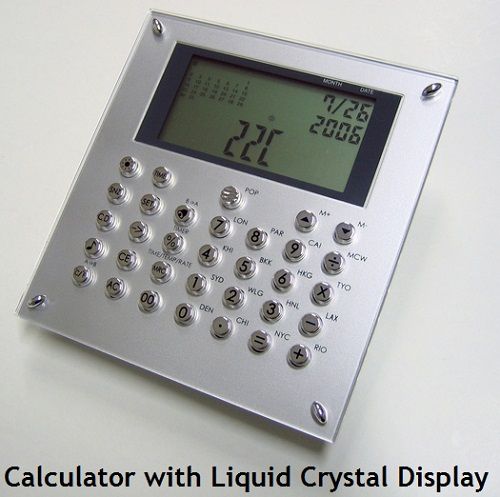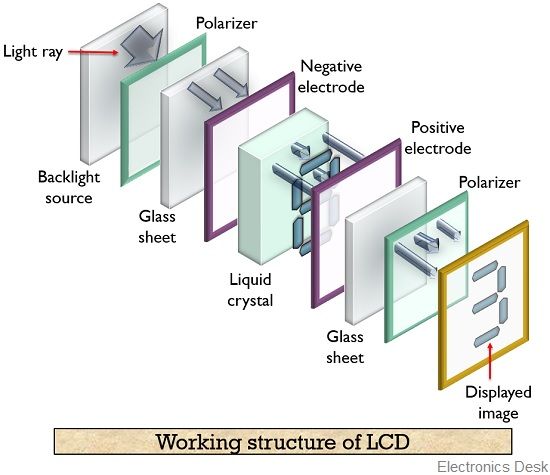Definition: LCD is an acronym used for Liquid Crystal Display. It is basically a display technique in which liquid crystals are used in order to produce an image on the screen.
Unlike an LED, an LCD does not hold the property of producing light. However, it allows some regions to appear either bright or dark by controlling the light energy emitted by an external source.

Now, before discussing how an LCD operates, it is necessary to have an idea about the liquid crystals.
What are Liquid Crystals?
Liquid crystals are considered as the 4th state of matter. This is so because they are neither solids nor liquids. But they possess the properties of crystal and holds the ability to flow or move like liquid. In their crystalline structure, the molecular orientation resembles like solid. However, these molecules also show movement in various positions. Thereby holding the property of solid as well as liquid. Therefore known as liquid crystal.
This liquid crystal displays the images or characters as the light emitted by the source can be either passed or obstructed by the molecular movement of the crystal. In liquid crystal display, twisted nematic type crystal is basically used. This is so because the molecules of this nematic crystal are somewhat naturally twisted at an angle of about 90°. Also, according to the applied potential, the molecules show untwist at changing degrees.
Construction of LCD
The figure below represents the structural arrangement of an LCD:

The liquid crystal having a thickness of nearly about 10 to 20 micrometres is placed between two glass sheets. On the inner surface of the two glass sheets, conductors are inserted. These conductors form electrodes. The two electrodes show positive and negative polarity to be applied. The external potential is provided to the display unit with the help of these two electrodes. These are basically formed by materials like indium oxide (IN2O3) and stannic oxide (SnO3).
Here, a fluorescent light source is used. The light emitted by this source is then fed to the polarizer here we have considered a vertical polarizer as the input polarizer. Also, a polarizer of opposite polarity as that of input is placed at another end of the display unit. So, here if we have assumed vertical polarizer as the input polarizer then at the other end it must be a horizontal polarizer. At the opposite end of the electrode, a glass cover is placed at which the desired image is displayed.
Let us now understand how an LCD operates.
Working of LCD
As we already have the idea that LCD is not an electroluminescent device. This means it does not has light-producing property instead of that it allows light to appear bright or dark by making use of a liquid crystal. Now, let us proceed to understand the operation of LCD.
The figure represented below will help you to have a better understanding of the working of an LCD:

When light from a backlight source is emitted and allowed to fall on the vertical polarizer. Then the unpolarized light by the source gets vertically polarized. When initially no external potential is provided between the two electrodes, the molecules of the liquid crystal remain twisted. This causes the vertically polarized light to get horizontally polarized due to the orientation of the molecules.
As we have discussed that the orientation of the two polarizers is 90° in accordance with each other. Thus, the polarizer at the other end is a horizontal polarizer. Hence, when the horizontally polarized light from the output of the nematic crystal is fed to the horizontal polarizer then it passes the light thereby causing illumination of the pixel. Hence, generates a visible image on the screen.
Suppose when a large voltage is applied between the two electrodes. Then this applied voltage causes the twisted mechanism of the molecules to get damaged causing them to operate in a straight manner. Due to this, the vertically polarized light while passing the nematic crystal does not change its polarization. This blocks the vertically polarized light to pass the horizontal polarizer thereby generating a dark pixel at the display. In this way, bright and dark images are generated.
Now the question strikes our mind that how an LCD shows images or characters of different sizes?
The answer to this question is that by applying a controlled voltage between the two electrodes it becomes possible to generate various colour levels on the screen.
As we know that a pixel is nothing but a colour element that is formed by the combination of 3 colours red, green and blue. So, by applying a certain voltage to the electrode the vertically polarized light can be passed through the output polarizer in various amounts.
![]()
Hence, it can produce various colour levels on the screen of the Liquid crystal display.
Tabular representation of characteristics of LCD

Advantages of LCD
- The heat generated during operation is less as compared to CRT and LED display.
- The power consumption by an LCD is very less in comparison to other display devices.
- LCDs can be suitably used with MOS integrated circuits.
- The overall cost of the device is low.
Disadvantages of LCD
- It needs an external source of light for displaying the image.
- Its operating temperature range is limited that lies in between 0 to 60°C.
- LCDs are less reliable display units.
- The image visibility relies on light intensity.
Applications of LCD
LCD finds its major applications in displaying the images on the screens of various electronic gadgets like television, calculator, computer monitor etc. These are also used in digital watches and mobile screens. These are also used in visualizing RF waves in transmission through waveguides and in medical applications like in liquid crystal thermometers etc.
Nice Explanation @Liquid Crystal Display
Grt article.. thanks